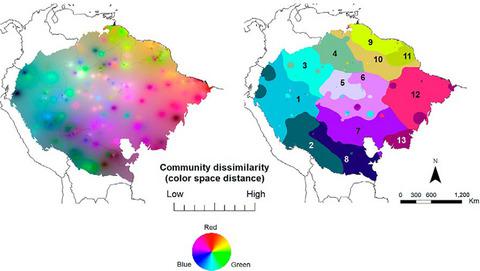Our official English website, www.x-mol.net, welcomes your
feedback! (Note: you will need to create a separate account there.)
Woody plant subregions of the Amazon forest
Journal of Ecology ( IF 5.3 ) Pub Date : 2020-04-17 , DOI: 10.1111/1365-2745.13406 Karla J. P. Silva‐Souza 1 , Alexandre F. Souza 1
中文翻译:

亚马逊森林的木本植物子区域
更新日期:2020-04-17
Journal of Ecology ( IF 5.3 ) Pub Date : 2020-04-17 , DOI: 10.1111/1365-2745.13406 Karla J. P. Silva‐Souza 1 , Alexandre F. Souza 1
Affiliation

|
- The Amazon forest covers 7.5 million km2 in nine countries, hosts 25% of the global biodiversity and is a major contributor to the biogeochemical and climatic functioning of the Earth system. Despite its global importance, a regionalization of the Amazon tree flora is still lacking. Clear and data‐driven delimitation of subregions is important for macroecological studies, to the identification of metacommunities and is a requisite for conservation planning.
- We aimed at identifying and mapping plant species subregions and investigated their relationships with environmental, historical and human correlates. We provide the first woody plant regionalization of the entire Amazon forest using a data‐driven approach based on assemblage composition patterns.
- We compiled data on woody species composition from 301 assemblages based on species occurrences. We then used unconstrained ordination, interpolation and clustering techniques to identify and map discrete woody subregions. Hierarchical clustering analysis was conducted in order to investigate the relationships between the identified subregions. We used multinomial logistic regression model and deviance partitioning to investigate the influence of environmental, historical and human factors on subregions distribution.
- We identified 13 woody subregions in the entire Amazon forest. The hierarchical subregion classification showed a broad Andean‐Cratonic east–west division. Variation in subregions was explained jointly by human factors and spatial structure followed by environmental factors and spatial structure combined.
- Synthesis. Our woody plant subregions differed from World Wildlife Fund ecoregions and physiognomic‐based maps, highlighting the importance of basing regionalizations on taxon‐specific groups and confirming that vegetation maps should not be used as proxies to plant diversity subregions. Our findings also confirm the need for multiple and extensive protected areas in the Amazon forest. The relevance of current climate factors in our study alerts to a profound impact that climate change could have on the spatial organization of the Amazon flora.
中文翻译:

亚马逊森林的木本植物子区域
- 亚马逊森林覆盖7500000公里2在九个国家,主机全球生物多样性的25%,并且是一个主要贡献者对地球系统的生物地球化学和气候运作。尽管具有全球重要性,但仍缺乏亚马逊树木区系的区域化。分区的明确和数据驱动的划界对于宏观生态学研究,对元社区的识别非常重要,并且是保护规划的必要条件。
- 我们旨在识别和绘制植物物种分区,并调查了它们与环境,历史和人类之间的关系。我们使用基于组合组成模式的数据驱动方法,提供了整个亚马逊森林的第一个木本植物分区。
- 我们根据物种发生情况,从301个组合中收集了木质物种组成的数据。然后,我们使用无约束的排序,内插和聚类技术来识别和映射离散的木质子区域。为了调查确定的子区域之间的关系,进行了层次聚类分析。我们使用多项逻辑回归模型和偏差划分来研究环境,历史和人为因素对分区分布的影响。
- 我们在整个亚马逊森林中确定了13个木质分区。分层的次区域分类显示出广泛的安第斯-克拉托尼克东西方划分。次区域的变化是由人为因素和空间结构共同解释的,其次是环境因素和空间结构的综合解释。
- 合成。我们的木本植物分区不同于世界野生动物基金会(World Wildlife Fund)生态区和基于地貌的地图,突显了将区域化基于特定分类群的重要性,并确认植被图不应用作植物多样性分区的代理。我们的发现还证实了在亚马逊森林中需要多个广泛的保护区。在我们的研究中,当前气候因素的相关性提示气候变化可能对亚马逊植物区系的空间组织产生深远影响。











































 京公网安备 11010802027423号
京公网安备 11010802027423号